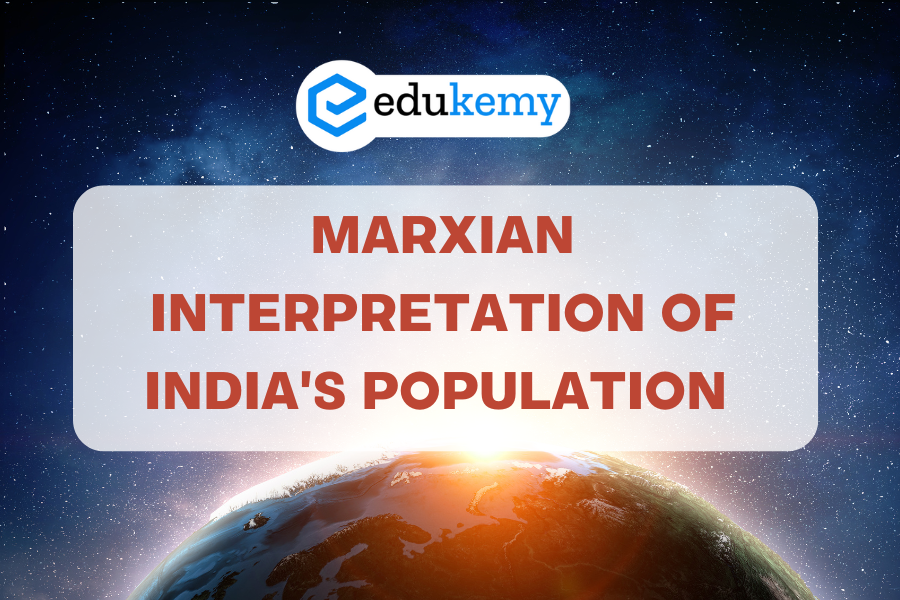Explore Marxian interpretation of India’s population, linking growth, economy, and class relations for deeper insights into population dynamics.

Contents
Introduction
Karl Marx rejected Malthusian population theory, which postulated that population grows exponentially while resources grow arithmetically, leading to inevitable resource scarcity and poverty. Instead, Marx argued that poverty and resource scarcity were not the result of population growth but the unequal distribution of resources and exploitation inherent in the capitalist system. According to Marx, population issues are socio-economic rather than natural phenomena.
Check Shabbir Sir’s Class Notes
Click Here to download
Relevance of Marxian Theory to Indian Population
India, as a developing country, exhibits many characteristics that align with Marxian interpretations. The dynamics of population growth in India can be analyzed through the lens of economic inequality, labor exploitation, and class struggles, providing deeper insights into demographic trends and their socio-economic implications.
1. Population and Economic Structures
Marxian theory emphasizes that the relationship between population growth and economic development is mediated by the prevailing mode of production. In the Indian context:
- Colonial Legacy: During British rule, population growth was not the primary issue; rather, the exploitation of India’s resources and labor under colonial capitalism led to poverty and famines.
- Post-Independence Industrialization: The shift from an agrarian to an industrial economy created new demographic challenges, such as urban migration, slum formation, and unemployment. These issues can be understood as the result of unequal development rather than mere population growth.
2. Reserve Army of Labor
Marx described the concept of the “reserve army of labor” – surplus labor created by capitalist systems to suppress wages and maximize profits. In India:
- Rapid population growth, coupled with inadequate job creation, has led to a large pool of unemployed and underemployed individuals.
- This surplus labor benefits capitalists by keeping wages low and ensuring a steady supply of cheap labor, particularly in sectors like agriculture, construction, and the informal economy.
3. Urbanization and Class Struggle
Indian cities are marked by stark socio-economic disparities, a phenomenon that can be explained through Marxian theory:
- The concentration of wealth and resources among the capitalist class has resulted in the proliferation of urban slums, poor living conditions, and inadequate access to basic services for the working class.
- The struggle for housing, employment, and social services among the urban poor reflects the broader class struggles highlighted by Marx.
4. Agrarian Distress and Population
Marx’s analysis of agrarian economies provides a framework for understanding India’s rural population:
- The capitalist penetration into agriculture has disrupted traditional agrarian structures, leading to landlessness, rural indebtedness, and farmer suicides.
- These phenomena, coupled with population pressure on limited land resources, exacerbate rural poverty and drive migration to urban areas.
5. Inequality and Social Stratification
Marxian theory also sheds light on the intersection of class and population in India:
- The capitalist system perpetuates socio-economic inequalities, with marginalized communities, such as Dalits and Adivasis, bearing the brunt of poverty and resource scarcity.
- Population growth among these marginalized groups is often higher due to lack of access to education, healthcare, and family planning services, further entrenching their economic vulnerability.
Criticism of Marxian Interpretation
While the Marxian perspective provides valuable insights, it is not without its criticisms:
- Critics argue that Marx underestimated the role of population growth as an independent variable influencing economic and social outcomes.
- The Marxian approach often overlooks environmental constraints and the ecological impacts of population growth, which are critical in the Indian context.
- The focus on class struggle sometimes ignores the role of cultural and institutional factors in shaping population dynamics.
Conclusion
The Marxian interpretation of population offers a critical lens to analyze the socio-economic dimensions of population growth in India. It underscores the importance of addressing structural inequalities and systemic exploitation rather than viewing population growth as the root cause of poverty and underdevelopment. For geography optional students, integrating this perspective into their understanding of population theories can provide a nuanced approach to tackling questions on population and development in the UPSC examination.
To get free counseling/support on UPSC preparation from expert mentors please call 9773890604
- Join Geography Optional Course – Click Here
- Get Geography Hard Copy notes – Click Here

